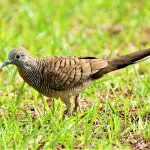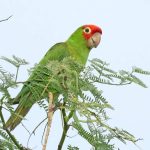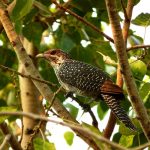Melodious laughingthrush | image by Ron Knight via Flickr | CC BY 2.0
The melodious laughingthrush (Garrulax canorus) is a medium-sized, brightly colored songbird found in the forested regions of Southeast Asia. It is named for its distinctive, melodic song, which is often described as “laughing” in nature.
This species is known for its striking appearance, with a bright blue-black head and breast, and a yellow-orange belly. The melodious laughingthrush is found in a variety of forest habitats, including primary and secondary forests, as well as gardens and parks. It feeds on a diet of insects, fruits, and seeds, and is often seen foraging on the ground or in the underbrush.
Common Name: Melodious Laughingthrush
Scientific Name: Garrulax canorus| Size | Diet | Range in Hawaii | Status in Hawaii |
|---|---|---|---|
| 8 in. | insects, berry and seeds | Oahu, Kauai, and Hawaii | least concern |
Melodious Laughingthrush
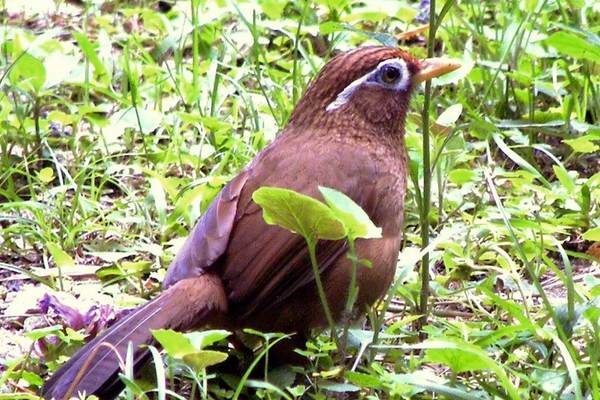
Appearance
The melodious laughingthrush is a medium-sized songbird with a striking appearance. It has a bright blue-black head and breast, and a yellow-orange belly.
The wings and tail are fairly long, and the bird has a thin, pointed bill that it uses to feed on insects, fruits, and seeds. The melodious laughingthrush is about the size of a sparrow, measuring about 8 inches in length and weighing around 1.5 ounces. It has a relatively round, compact body, and its overall coloration is quite striking, with a bold combination of blue, black, and orange tones.
Diet
The diet of the melodious laughingthrush consists mainly of insects and other invertebrates, such as worms, snails, and spiders. It also feeds on a variety of fruits, including berries, and may occasionally consume seeds and nectar.
In the wild, melodious laughingthrushes can be found foraging for food on the ground and in the underbrush, as well as in trees and bushes. They are known to be opportunistic feeders and will take advantage of whatever food sources are available to them. In captivity, melodious laughingthrushes can be fed a diet of commercial birdseed mix supplemented with insects, fruits, and vegetables.
Behavior
Melodious laughingthrushes are known for their beautiful, melodic songs and calls, which they use to communicate with each other and defend their territories. They are active, social birds that are often seen foraging for food in small groups or in pairs. They have a wide range of vocalizations and are known to mimic the sounds of other birds and animals.
These birds are primarily ground-dwelling birds, but they are also adept at climbing and perching in trees and bushes. They are active during the day and are most vocal in the early morning and late afternoon. These birds are non-migratory and tend to stay in the same area year-round.
In addition to singing and foraging, melodious laughingthrushes engage in a variety of other behaviors, such as preening and bathing. They are known to be quite territorial and will defend their territory from intruders through vocalization and physical displays. They may also engage in courtship rituals, such as singing and displaying, in order to attract a mate.
Nesting
Melodious laughingthrushes build nests in trees, shrubs, or other vegetation, often at a moderate height above the ground. The male melodious laughingthrush is responsible for building the nest, which is a shallow cup made of twigs, grasses, and other plant materials. The nest is lined with softer materials such as feathers and moss to provide insulation and comfort for the eggs and chicks.
Once the nest is completed, the female melodious laughingthrush lays a clutch of 3-5 eggs, which are incubated by both parents for about 13-14 days. The chicks hatch altricial (helpless and naked) and are fed by both parents until they fledge (leave the nest) at around 10-12 days old.
Habitat
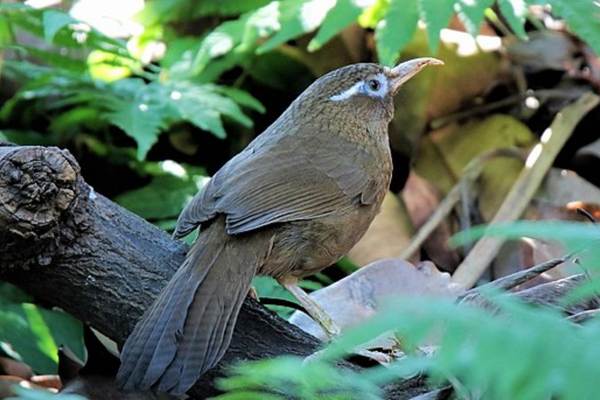
They are found in a variety of forested habitats, including deciduous forests, evergreen forests, and mixed forests.
Range
It is native to South and Southeast Asia, and has been introduced to the Hawaiian Islands. In Hawaii, the melodious laughingthrush is found on the islands of Oahu, Kauai, and Hawaii.
Conservation Status
The melodious laughingthrush is not native to the Hawaiian Islands and was introduced to the islands through the pet trade. It is considered an invasive species in Hawaii, as it has established populations on the islands and is capable of competing with native birds for food and habitat. The species is not listed on the IUCN Red List of Threatened Species, and there is no specific conservation status for the species in Hawaii.
Interesting Facts
1. They’re known for their beautiful, melodic songs
Melodious Laughingthrushes are known for their beautiful, melodic songs, which they use to attract mates and defend their territories. It is possible that their songs may be heard in some areas of Hawaii where they have established populations.
2. Considered invasive species in Hawaii
They are not considered to be a major conservation concern in Hawaii, as they are not a common species in the state. However, it is important to monitor their populations and assess any potential impacts they may have on native bird species.
3. They are social birds
Melodious Laughingthrushes are social birds, and are often found in small groups or flocks. They are known to be quite gregarious and will often forage for food together.
FREQUENTLY ASKED QUESTIONS:
What do Melodious Laughingthrushes eat?
Melodious Laughingthrushes are omnivorous, and will feed on a variety of different foods, including insects, fruits, seeds, and nectar. They are known to be opportunistic feeders, and will take advantage of whatever food sources are available.
Do Melodious Laughingthrushes migrate?
Melodious Laughingthrushes are non-migratory birds, meaning they do not migrate long distances. However, they may make short-distance movements within their range in response to changes in food availability or weather conditions.
Are Melodious Laughingthrushes endangered?
The Melodious Laughingthrush is not currently considered endangered, although it is listed as a species of “Least Concern” on the International Union for Conservation of Nature (IUCN) Red List. However, like many bird species, it may be at risk due to habitat loss and other human activities.

